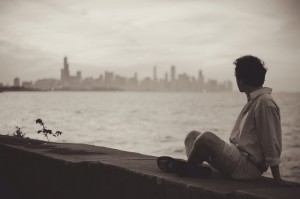- Calls to this hotline are currently being directed to Within Health or Eating Disorder Solutions
- Representatives are standing by 24/7 to help answer your questions
- All calls are confidential and HIPAA compliant
- There is no obligation or cost to call
- Eating Disorder Hope does not receive any commissions or fees dependent upon which provider you select
- Additional treatment providers are located on our directory or samhsa.gov
Bulimia in the Gay Community
Article Contributed By: Brad Kennington, LMFT, LPC is a therapist in private practice and Randall Lopez is currently a graduate student in the Master of Arts Counseling Program at St. Edward’s University, both are in Austin, Texas.

For some in the gay community, gay pride may mask gay shame as more than 15% of gay and bi-sexual men struggle with some form of disordered eating. The pressures to achieve the so-called gay “ideal” physique–a body that is both lean and muscular—are enough to drive some into a dangerous relationship with their bodies, food, and exercise.
The Already Added Stigma of Being Gay
Consider for a moment the larger context in which many gay men must live. In many states, their marriages are not legal or they can be fired from a job simply for loving someone of the same sex. Their place of worship may label them as an abomination and their families may completely disown them.
Now consider the amount of shame gay males must carry and how terribly heavy that shame must feel. And eating disorders are exactly about that–heavy, weighty feelings. It begs the question: Where do all those feelings go?
People Value Attractiveness

And in the gay culture, the body, like real currency, provides one with power, status and recognition. But too often the investment strategy is one that leads to high risk behaviors—extreme dieting, bingeing, purging, excessive exercising—that yield a return that can leave one emotionally and physically bankrupt.
The Objectification of Male Bodies
Research shows that the male body is sexually objectified within the gay culture, much like women’s bodies are in the straight culture. And with this sexual objectification comes obsessive body checking and comparing and a desire to make the cut and be approved as sexually desirable. But if you don’t meet the gay standard, then what?
Not measuring up to the gay ideal can lead to the development of body shame. (See a pattern of shame developing?) And body shame can lead one right into eating disorder behaviors in an attempt to deal with these heavy feelings and fears of being rejected by one’s peers.
Extreme Measures to Stave of Shame

What then surfaces is all of the guilt and even more shame and an intense fear of becoming “fat” and a failed gay. But a trip to the restroom or several hours at the gym tomorrow and a promise to oneself to keep dieting will take care of those feelings, or so one thinks. And thus the bulimic cycle is born.
Relationships a Factor in Bulimia
Bulimia has also been shown to be connected to how a gay man feels within his relationships. Research shows that having unsatisfied friendships is a risk factor for bulimia. Another study indicated that not being happy in one’s romantic relationship also increased the likelihood for bulimic behaviors.
Gay men are often marginalized, and not having a solid social support system in place can certainly increase feelings of isolation and depression.
In an attempt to fill the void and aching emptiness and to stuff down these strong negative feelings, some may turn to food as an emotional substitute, a surrogate of sorts, to ease the loneliness and to feel full.
And to ensure that his body does not become the symbol of failure in the gay society—which would only lead to more isolation and loneliness—compensatory behaviors are used to rid himself of the excessive calories.
A Negative Feedback Cycle
It is a cycle of secrecy and shame that can take on a parasitic life of its own as the bulimia attaches to its host and provides a pseudo sense of comfort within a community where the body becomes the battleground for one’s soul and identity.
For too many gay men this battle over his body starts at a very early age. Research shows 31 percent of gay men have a history of childhood sexual abuse. This same study also found that a history of childhood sexual abuse was related to bulimia.
Binging, purging, excessive exercising become the coping behaviors employed by a gay man as he struggles to manage the intense and overwhelming feelings of depression, anxiety, and shame that are a result of his being sexually traumatized.
Marginalized in an Already Marginalized Culture
Marginalized by many in our larger culture; pressures from within one’s own subculture to achieve the “ideal” body; loneliness and isolation; and high rates of sexual abuse. It is a perfect storm scenario for the development of eating disorders and for bulimia in particular.
All of us, whether we are gay or straight, a clinician or a layperson, or simply a caring Mom, Dad or sibling, can help by understanding the unique challenges a gay man struggles with.
Accepting him for who he truly is as he steps further and further out of the safe yet suffocating confines of his closet and into the larger human family can help assuage some of the shame he may feel. Listen to his story. Connect with him. Validate his being someone. And encourage him to get the help he needs if he is struggling.
References:
- Brown, T.A., & Keel, P.K. (2013). The impact of relationships, friendships, and work on the association between sexual orientation and disordered eating. Eating Disorders: The Journal of Treatment & Prevention, 21(4), 342-359.
- Brown, T.A., & Keel, P.K. (2012). The impact of relationships on the association between sexual orientation and disordered eating. International Journal of Eating Disorders, 45(6), 792-799.
- Carlat, D.J., Camargo, C.A., & Herzog, D.B. (1997). Eating disorders in males: A report of 135 patients. American Journal of Psychiatry, 158(8), 1127-1132.
- Feldman, M.B., & Meyer, I.H. (2007). Childhood abuse and eating disorders in gay and bisexual men. International Journal of Eating Disorders, 40(5), 418-423.
- Feldman, M.B., & Meyer, I.H. (2007). Eating disorders in diverse lesbian, gay and bisexual populations. International Journal of Eating Disorders, 40(3), 218-226.
- Seidman, S.N. & Reider, R.O. (1994). A review of sexual behavior in the United States. American Journal of Psychiatry, 151, 330-341.
- Wiseman, M.C., & Moradi, B. (2010). Body image and eating disorder symptoms in sexual minority men: A test of extension of objectification theory. Journal of Counseling Psychology, 57(2), 154-166.
About the Authors:
Brad Kennington, LMFT, LPC is a therapist in private practice in Austin, Texas. Brad specializes in the treatment of eating disorders, relationships, anxiety and sexual orientation issues. He is also an associate faculty and clinical supervisor at the Austin Family Institute. You can learn more about his work by visiting bradkennington.com.
Randall Lopez is currently a graduate student in the Master of Arts Counseling Program at St. Edward’s University in Austin, Texas. Randall’s clinical interests include body image issues and eating disorders in the gay community.
